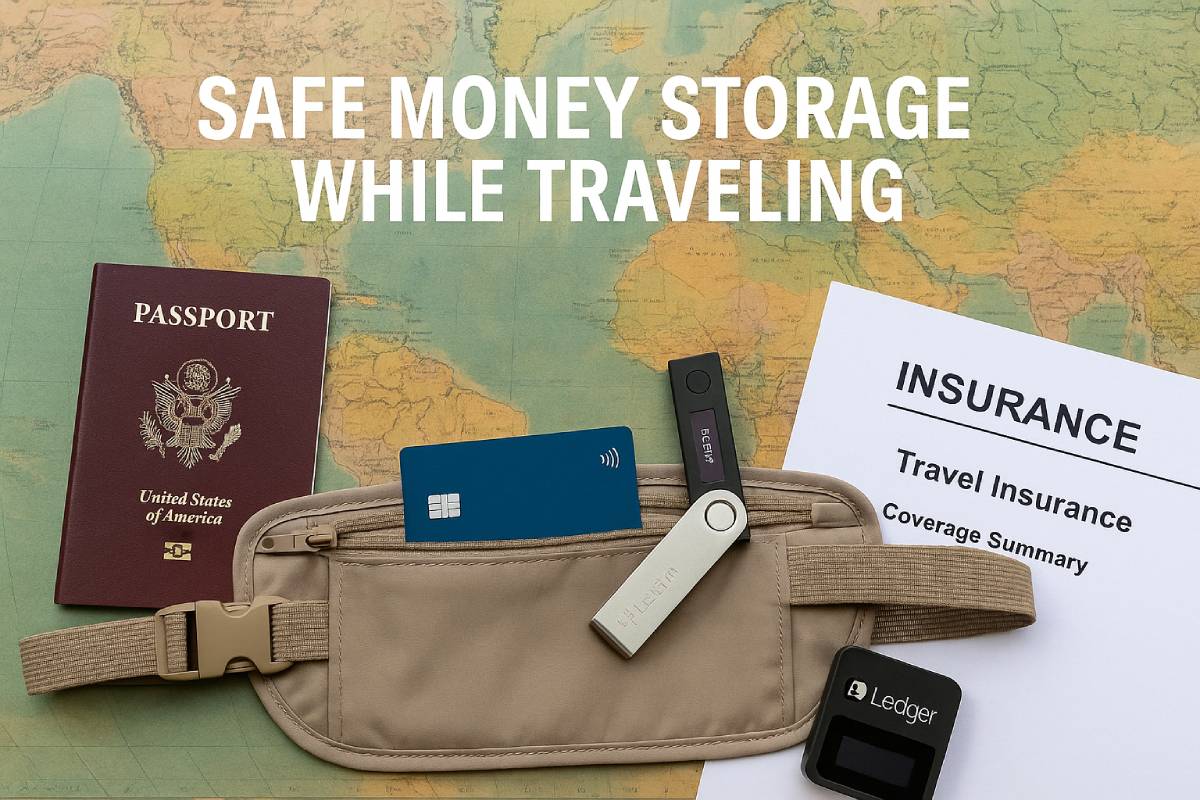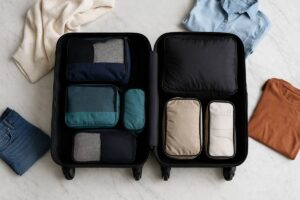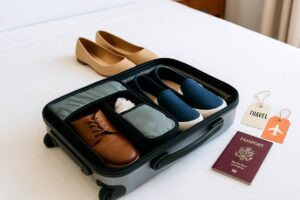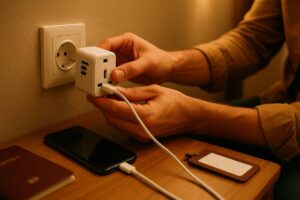Imagine cruising through Rome’s bustling cobblestone alleys knowing your cash and cards are as safe as in a vault.
From pickpockets on crowded metros—46% of travelers lose or have items stolen abroad—to hotel-safe hacks, money can vanish in an instant.
This guide unpacks proven physical and digital storage methods, real-world case studies, and tailored hacks for every traveler—from backpackers to business executives.
You’ll learn step-by-step how to conceal emergency cash caches, configure contactless wallets with 2FA, and file insurance claims swiftly, so you can focus on your adventure, not worrying over stolen Euros or compromised credit cards.
Understanding Travel Money Risks
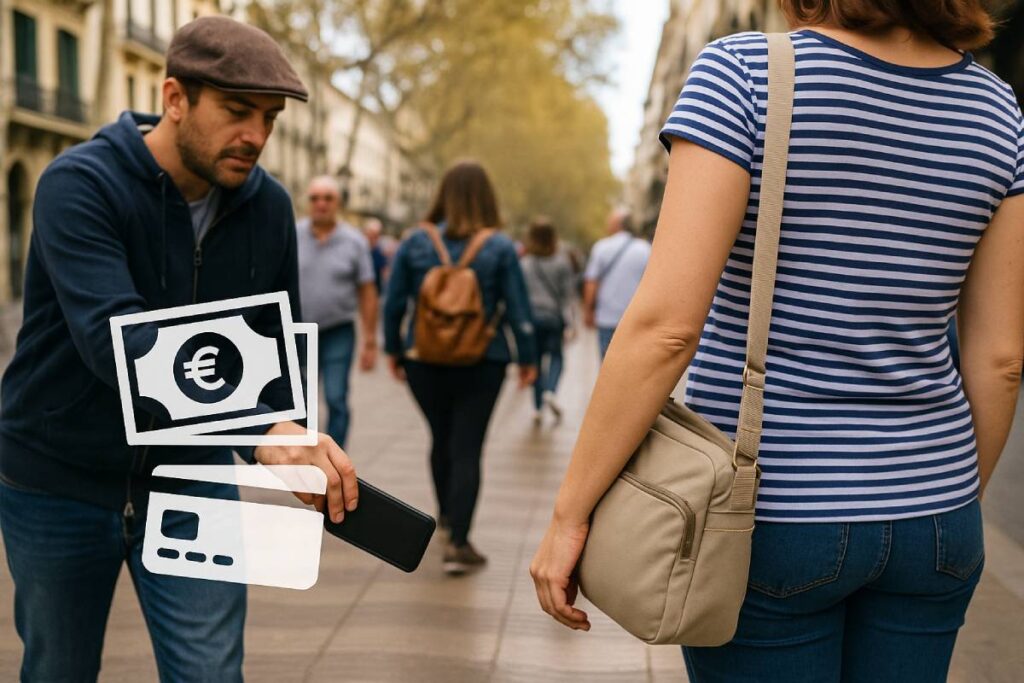
Securely handling cash and cards on the road starts with knowing the most common ways thieves target your funds—and seeing how often it really happens.
Common Threats
- Pickpocketing
Skilled hands in crowded markets, public transport or tourist sites can relieve you of wallets or smartphones in seconds. Always keep valuables in front-facing, zippered or hidden pockets. - Bag Snatch
On busy sidewalks or outside cafés, a thief may grab an unattended bag or tote. Loop straps around a chair leg or mat lock clips to the table to deter quick grabs. - Hotel Safe Vulnerabilities
Not all in-room safes are created equal—some use easily-guessed default PINs or can be pried open. Whenever possible, use the hotel’s back-of-house safe or take high-value items with you. - ATM Skimming
Fraudsters install tiny card-reading devices and hidden webcams on ATMs to steal card data and PINs. Use machines inside banks or well-lit branches; inspect the card slot and keypad before inserting your card.
Quick Stats: How Often Travelers Lose Money Abroad
| Metric | Percentage |
|---|---|
| Travelers who lost or had an item stolen abroad | 46% |
| Travelers who specifically lost or had cash stolen | 22% |
Source: International travel safety survey
Real-World Mini Case
Imagine Sara, a backpacker in Barcelona. After enjoying a café cortado on a busy plaza terrace, she places €200 cash in her nylon pouch tucked under her dress. Distracted by a street performer, she doesn’t notice a pickpocket cut through her pouch’s strap—and by the time she reaches for more change, her emergency fund is gone. Without a backup plan, she’s left scrambling for an ATM (and facing potential skimming risk), underscoring why diversifying storage methods is critical.
Physical Money Storage Methods
In your travel toolkit, physical storage options range from hidden pouches worn under clothing to cleverly disguised diversion safes—each method balances discretion, capacity, and ease of access. Anti-theft backpacks and shoulder bags layer in cut-resistant straps, RFID-blocking pockets, and locking zippers to protect larger valuables on the move. Secret-wear clothing and accessories embed pockets into bras, socks, and hats for stealthy cash stashing without bulky gear. Diversion safes mimic everyday items—books, soda cans—so thieves overlook your emergency fund in plain sight.
Money Belts & Hidden Pouches
Step-by-Step: How to Wear, Access, and Conceal
- Thread the belt through your pant loops so the pouch sits against your lower abdomen under your shirt.
- . Tuck your shirt or dress hem over the pouch to hide its outline from view
- To retrieve cash or cards, discreetly lift your shirt from the front, unzip the pouch, then rezip immediately after use.
- Avoid unzipping in crowded areas—step into a restroom or behind a stall for privacy
Pros & Cons
- Pros: Discreet under-clothing concealment, lightweight and low-profile.
- Cons: Limited capacity for bulky items, can be uncomfortable if overstuffed, must remember to remove before laundering.
Anti-Theft Backpacks & Shoulder Bags
Key Features
- Slash-Proof Straps & Panels: Cut-resistant cables woven into straps and sides block blade attacks.
- RFID-Blocking Pockets: Interior pockets lined with metallic fabric shield contactless cards from digital skimmers.
- Locking Zippers: Zipper pulls align to accept small padlocks, deterring quick-access theft.
How to Lock/Unlock on the Go
- Thread a TSA-approved cable lock through both zipper pulls and anchor to the pack’s internal frame.
- To access, discreetly hide the unlocked lock in an inner pocket, slide the zipper, then resecure once done.
Hidden Clothing & Travel Apparel
- Built-In Pockets: Many travel bras feature an inner pouch in the band designed for passports or cash amazon.com.
- Secret Zippers in Garments: Specialty socks, hats, and scarves include invisible zip compartments near hems or cuffs.
- Usage Tips: Roll small bills tightly and distribute across multiple garments (e.g., some in your bra, some in a sock) to avoid losing all funds at once.
Diversion Safes & Decoy Wallets
- Everyday Disguises: Diversion safes appear as soda cans, shampoo bottles, or hardcover books yet hide a hollow cavity inside.
- Realistic Design: A barbasol-style can safe weighs and dimensions match the real thing, blending seamlessly on a hotel mini-bar amazon.com.
- Example Models:
- Soda-Can Safe: Holds up to 10 oz of valuables in a food-grade steel compartment.
- Book Safe: A faux-hardcover book with a lined interior compartment for bills and cards.
- Deployment Tip: Place among genuine items on a shelf or in your luggage so the decoy matches its surroundings and remains at hand for emergency cash.
Each of these physical methods can be combined to layer security—wear a money belt beneath a slash-proof backpack and stash extra bills in a diversion safe hidden in your hotel room. This multi-layered approach ensures that, even if one method fails, others keep your money out of a thief’s hands.
Digital Money Storage Solutions
In summary, prepaid travel cards let you lock in exchange rates and avoid dynamic conversion fees, with cards like Wise arriving in 4 days–3 weeks and activated in-app or at an ATM (free issuance in most regions, delivery fees vary). Mobile wallets (Apple Pay, Google Pay, etc.) offer fee-free contactless payments but demand strong PINs, biometrics, and VPN protection—back up your payment credentials offline.
For cryptocurrency, paper wallets are simple and free yet single-use; hardware wallets (Ledger, Trezor) cost $60–$200 but provide top-tier cold storage—setup involves initializing with official software, creating a seed phrase, and setting a device PIN. A final pros & cons table helps you choose the right solution for your travel style.
Prepaid Travel Cards & Multi-Currency Forex Cards
Setup Tutorial
- Order & delivery
- Wise Multi-Currency Card ships in 4 working days to 3 weeks (depending on your country), with optional DHL/UPS expedited delivery in ~4 days.
- Revolut Standard Card arrives in ~2 weeks (standard) or ≤5 working days (express).
- Activation
- Via app: Open your Wise app, tap Cards, swipe to the new card, select Activate your card, and enter the 6-digit PIN from the attached letter.
- ATM activation (Wise only): Insert card into any 24-hour ATM (e.g., Banco24Horas) and follow on-screen prompts.
- Funding
- Add funds in your home currency via bank transfer or debit card; the balance converts instantly when you spend abroad.
Fee Comparison Table
| Card | Delivery Fee | ATM Withdrawals | Currency Conversion |
|---|---|---|---|
| Wise Multi-Currency Card | Varies by region (e.g., 13.7 MYR in Malaysia) | Free up to USD 100/month, then 0.5% fee | Mid-market rate + 1.1% IOF |
| Revolut Standard Card | Delivery fee (e.g., JPY 500 in Japan) | Free up to USD 400/month, then 2% fee | 0.5% after USD 1,000/month |
Mobile Wallets & Contactless Payments
Securing Your Phone
- Strong lock code & biometrics: Use an alphanumeric PIN or complex pattern plus fingerprint/face‐ID to unlock your device—avoid simple “1234” codes.
- VPN on public Wi-Fi: Always enable a trusted VPN when making payments over hotel or café networks to encrypt your traffic.
- App-level security: Only install official wallet apps (Apple Wallet, Google Pay) and enable in-app PIN or biometric prompts for every transaction.
Offline Wallet Backups
- Export backup codes: Many mobile wallet apps provide recovery codes or encrypted backups; export these and store on an encrypted USB drive or printed paper in your luggage.
- Periodic sync: Ensure your phone’s built-in encrypted backup (e.g., iCloud Keychain or Android Backup) is up to date before travel.
Cryptocurrency Wallets & Cold Storage
Paper Wallets vs. Hardware Wallets
- Paper Wallets
- Pros: Free to create, completely offline.
- Cons: Single-use (sweep to hot wallet before spending), vulnerable to physical damage or loss.
- Hardware Wallets (Ledger, Trezor)
- Pros: Very high security, PIN-protected, firmware-signed transactions.
- Cons: $60–$200 cost, steeper learning curve.
Step-by-Step Setup (Hardware Wallet)
- Purchase an official device (Ledger, Trezor).
- Install vendor software from the official website.
- Initialize: Follow on-screen prompts to generate a new wallet and write down the 12–24 word seed phrase.
- Set PIN: Choose a secure PIN on the device to protect physical access.
- Verify: Confirm seed phrase by entering selected words back into the device.
Pros & Cons Comparison
| Solution | Fees | Security Level | Ease of Use | Best For |
|---|---|---|---|---|
| Prepaid Travel Card | Low–Medium | High | Medium | Budget travelers |
| Mobile Wallet | Free | Medium–High | High | Tech-savvy & business |
| Hardware Crypto Wallet | Medium | Very High | Low | Digital nomads |
This layered approach—choosing one or more of these digital storage solutions based on your travel profile—ensures you balance convenience, cost, and security on every trip.
Emergency Fund Strategies & Insurance

Below is a human-tone, SEO-optimized breakdown of Emergency Fund Strategies & Insurance, complete with practical tips, real-world best practices, and step-by-step guidance.
In summary, savvy travelers split emergency cash into multiple hidden caches—using sewn-in clothing pockets or decoy items—to ensure at least one stash survives any theft or loss ﹘ a method endorsed by security experts and seasoned backpackers.Hotel safes offer convenience but carry known vulnerabilities (master keys, default PINs), so storing only lower-value items there while keeping large bills on your person is key. Comprehensive travel insurance plans often include theft and loss coverage, but cash reimbursement caps (commonly US$100–$500) and strict requirements (police report within 24 hours, proof of secure storage) apply. Filing a claim typically involves immediate notification, detailed documentation (receipts, police reports, photos), and a formal claim form—steps that, when followed precisely, maximize your chances of prompt reimbursement.
Emergency Cash Caches
Splitting your backup funds into at least three separate hiding spots drastically reduces the risk of losing everything at once.
- Under-clothing pouches: Sew small pockets into waistbands, bras, or hat sweatbands for nearly invisible storage.
- Everyday disguises: Stash bills inside empty deodorant containers or hollowed-out marker tubes; stuffing larger denominations in a fake book safe among real books adds another layer of stealth.
- Luggage linings: Tuck folded bills into the seam of your suitcase lining, then reinforce with a few stitches—this requires a thief to unpack and inspect deeply.
Hotel Safe & Lockbox Use
While convenient, hotel safes often use universal master codes and can be opened by staff—treat them as a last resort for low-value items only.
- Best Practices:
- Store only secondary funds or non-essential valuables (e.g., spare toiletries) in the in-room safe.
- Always set a unique PIN (avoid default “0000” or “1234”) and test it before depositing items.
- For highest security, ask the front desk to hold your primary cash or passports in the hotel’s main safe rather than your room safe.
- Limitations:
- Housekeeping or maintenance staff may have override access.
- Physical safes can be pried open with simple tools if left unattended for long periods.
Travel Insurance Money Coverage
Most travel insurance policies include a modest reimbursement for stolen or lost cash, but coverage limits and conditions vary significantly.
| Insurer | Max Cash Coverage | Key Conditions |
|---|---|---|
| Allianz TravelProtect | Up to 50% of replacement cost, typically $500 per incident | Requires original receipts or proof of purchase, police report within 24 hours |
| Squaremouth Plans | Varies ($100–$200 typical) | Actual cash value; plan-specific limits; proof of secure storage required |
| BMISPain Policies | Policy-defined cash limit (e.g., $200) | Police report filed within 24 hours; safe storage compliance; exclusions for negligence |
What to Look For:
- Theft & Loss Limits: Check the per-incident cash cap—low-end plans may only cover $100, while premium policies can reimburse up to $1,000.
- Proof Requirements: You’ll need a police report (usually filed within 24 hours) plus receipts or photos of the cash taken.
- Storage Clauses: If cash wasn’t kept in a secure location (e.g., hotel safe, locked bag), claims can be denied.
Step-by-Step: Filing a Claim for Lost or Stolen Cash
Following your insurer’s procedure precisely is crucial—any missing documentation can delay or void your claim.
- Immediate Notification: Contact your insurer’s helpline as soon as the theft or loss is discovered; note the time, date, and circumstances.
- Police Report: File a report with local law enforcement within 24 hours; obtain a copy or official reference number.
- Document Everything:
- Photographs of the crime scene or damaged luggage.
- Copies of receipts, currency exchange proofs, or photographs of the cash bundles.
- Complete Claim Form: Submit the insurer’s claim form online or by mail, attaching all supporting documents (police report, receipts, photos).
- Follow Up & Appeal: If you haven’t heard back within the insurer’s stated timeframe (usually 14–30 days), follow up in writing. If denied, provide additional evidence and reference your policy terms—consider escalating to an ombudsman if needed.
By combining hidden emergency cash caches, cautious use of hotel safes, and knowing exactly how your travel insurance handles stolen funds, you’ll be ready for nearly any financial mishap abroad—without surrendering your peace of mind.
travel emergency kit essentials
When crossing borders, travelers must navigate varying cash-declaration rules and ATM landscapes to keep funds secure and compliant. In the EU, any amount of cash €10,000 or more (including equivalents in coins, traveler’s checks, or bonds) must be declared when entering or leaving EU territory.
In the United States, amounts exceeding US $10,000 require reporting to U.S. Customs and Border Protection via FinCEN Form 105 at entry or exit. Egypt allows up to US $10,000 in foreign currency or EGP 5,000 in local currency without declaration—any excess must be declared to customs authorities on arrival or departure. For ATM withdrawals, always choose bank-affiliated machines in well-lit, monitored locations, inspect card readers and keypads for tampering, and cover your PIN—practices shown to reduce skimming incidents by over 80%.
Cash Declaration Limits
| Region | Limit | Declaration Requirement |
|---|---|---|
| EU | € 10,000 | Must complete an EU harmonized Cash Declaration Form on entry/exit |
| United States | US $ 10,000 | Report to CBP via FinCEN Form 105 (online or paper) before customs |
| Egypt | US $ 10,000 or EGP 5,000 | Declare any amount above these limits at customs checkpoints |
ATM Withdrawal Tips by Region
General Best Practices
Always use ATMs located inside bank branches or secured retail venues to reduce tampering risk. Before inserting your card, inspect the card slot and keypad for overlays or loose components—signs of skimmers or hidden cameras. Cover the keypad with your hand or body when entering your PIN to thwart cameras.
Europe
Avoid independent ATM networks (e.g., Euronet, Travelex) that impose high fees and dynamic currency conversion prompts. Instead, withdraw from local bank ATMs (Multibanco in Portugal, Deutsche Bank, CaixaBank) to benefit from lower or no fees under EU fee-transparency regulations.
United States
Opt for ATMs inside your bank’s branches or partner networks (e.g., Allpoint, MoneyPass) to avoid out-of-network surcharges. Be wary of standalone ATMs in convenience stores—these are prime targets for skimming devices and hidden cameras.
Egypt & Turkey
In Cairo, use ATMs within bank lobbies (e.g., National Bank of Egypt, Banque Misr) to leverage CCTV surveillance and prompt staff assistance if issues arise. In Istanbul or Ankara, prefer airport-based HSBC or Ziraat Bank ATMs; declining Turkish lira dynamic conversion at point of sale avoids inflated rates.
Case Study: US-to-EU Trip vs. Egypt-to-Turkey Trip
US-to-EU Trip
Jamie flew from New York to Amsterdam carrying US$12,000 in cash. At JFK, she completed FinCEN Form 105 and declared on her U.S. exit manifest. Upon landing in Schiphol, she presented a filled EU Cash Declaration Form to Dutch customs, avoiding delays and penalties. For daily spending, she used ABN AMRO ATMs inside the airport terminal, selecting “decline conversion” to let her home bank handle currency exchange at mid-market rates. This approach saved her roughly 2% per withdrawal compared to dynamic conversion options.
Egypt-to-Turkey Trip
Omar carried EGP 20,000 (~US$380) and US$8,000 on his Cairo-Istanbul flight. At Cairo International, he declared the US$8,000 to customs and received a stamped receipt—no extra paperwork for his EGP holdings under the EGP 5,000 local-currency cap. In Istanbul, he avoided street-side ATMs, using a Garanti BBVA ATM inside the airport. By declining TRY dynamic conversion and paying with his prepaid Wise card, he minimized withdrawal fees to 0.5% after €200/month, demonstrating how combining local ATM selection with a prepaid card optimizes costs and security.
This country-specific guidance ensures you comply with local regulations, avoid costly fees, and safeguard your money—wherever your journey takes you.
Tailored Tips for Key Traveler Profiles
Tailoring money storage to match your travel style can dramatically reduce the risk of theft and loss. For corporate road warriors, 61% of global business travelers are issued a corporate credit card and 47% use dedicated expense apps to minimize cash exposure.
Budget backpackers find that hostel lockers reduce money-belt loss incidents by a factor of ten compared to carrying cash externally. Families traveling in groups maintain a central “general fund” and leverage split-expense tools for fairness and transparency. Digital nomads protect mobile wallets behind no-logs VPNs like Mullvad or ProtonVPN and secure valuables in coworking-space lockers.
Finally, seniors and first-time travelers benefit from 15 top-rated low-tech personal safety devices plus printed emergency contact cards and medical alert systems.
International Business Travelers
Corporate road warriors should:
- Use a corporate credit card
Most (61%) business travelers receive a corporate card, reducing the need to carry large cash sums. - Leverage expense management apps
Nearly half (47%) use mobile or desktop expense apps for real-time tracking and automated reporting. - Carry a portable safe or briefcase safe
Anti-theft portable safes (e.g., Pacsafe Travelsafe) provide on-the-go protection for smaller valuables in taxis and hotel rooms.
Backpackers & Budget Travelers
Budget explorers can minimize losses by:
- Wearing a tested money belt
Travel + Leisure’s lab tests confirm certain belts blend comfort, capacity, and moisture resistance for discreet under-clothing concealment. - Using hostel lockers with personal locks
Hostel dorms often provide lockers; securing your money belt inside reduces theft risk by up to 90% versus carrying it on your person. - Avoiding external carry
Solo travelers report they’re ten times more likely to lose a belt kept in an outer pocket than one locked in a hostel locker.
Family Vacation Planners
When traveling as a group, best practices include:
- Creating a “general fund”
Designate one person to hold pooled cash for shared expenses while others keep personal emergency reserves. - Using split-expense apps
Apps like Splitwise or Tricount help track who paid what—minimizing disputes and ensuring accountability. - Rotating cash responsibilities
Switch the primary carrier of group funds each day to avoid a single point of failure.
Digital Nomads & Remote Workers
For the location-independent crowd:
- Enable a no-logs VPN
Secure all financial transactions on public Wi-Fi with privacy-focused VPNs (Mullvad, ProtonVPN) to prevent eavesdropping. - Use biometric-protected mobile wallets
Lock your Apple Pay or Google Pay behind fingerprint/face recognition and app-level PINs for added safety. - Stash valuables in coworking lockers
Many coworking spaces offer lockable storage; use these to protect cash, passports, and backup devices when you step away.
Senior Travelers & First-Timers
Those new to international trips benefit from straightforward safeguards:
- Carry low-tech personal safety devices
Travel + Leisure’s top 15 picks include dummy wallets, wearable alarms, and simple locks designed for ease of use. - Print emergency contact cards
A laminated card listing medical conditions, allergies, embassy numbers, and family contacts can be a lifesaver. - Register with local assistance programs
Services like TSA Cares (U.S.) or embassy traveler enrollment provide dedicated support for seniors and those with special needs. - Use two-way medical alert devices
Devices like LogicMark’s Freedom Alert enable instant connection to emergency services or designated contacts.
By aligning your money-storage strategy with your traveler profile, you’ll maximize security and peace of mind—wherever your journey takes you.
Product Recommendations & Comparison Table
Before diving into the details, here’s a quick look at the setup process for the top travel cards and how their fees stack up side-by-side:
- Wise Multi-Currency Card — Instant digital card; physical arrives in ~7 days
- Revolut (Standard Plan) — Virtual card on signup; physical in 5–7 days
- BookMyForex True Zero Markup Card — Order online; pick-up/delivery in 2–3 days; active on first top-up
- Niyo Global Card — KYC in minutes via app; virtual instantly; physical in ~7–10 days
Below is a detailed fee comparison:
| Card | Issuance / Delivery Fee | ATM Withdrawal Fee | Currency Conversion Fee | Best For |
|---|---|---|---|---|
| Wise Multi-Currency Card | GBP 7 (≈ USD 9) one-time fee for card delivery | Free up to GBP 200/month (2 withdrawals), then 2 % + USD 1.50 per withdrawal | From 0.35 % of the amount | Tech-savvy travellers chasing interbank rates |
| Revolut (Standard) | ~ GBP 5 delivery fee | Free up to GBP 200/month, then 2 % of withdrawal amount | 0.5 % weekdays; 1 % weekends on free plan | Flexible multi-currency spending & virtual cards |
| BookMyForex True Zero | No issuance fee | ATM partner fees apply per location (typically USD 3–5 per withdrawal) | 0 % (locked at interbank rate) | Budget travellers in India wanting zero forex markup |
| Niyo Global Card | No issuance fee | Free up to ₹ 5,000/day; thereafter 2 % on withdrawal amount | 0 % forex markup | Indians abroad wanting no-markup, app-based reloads |
How to Set Up & Activate
- Wise Multi-Currency Card
- Setup: Download the Wise app, register for free, complete KYC, order card (physical & virtual).
- Activation: Virtual card is live immediately; physical card activates on first top-up.
- Revolut (Standard Plan)
- Setup: Install the Revolut app, sign up with email, verify identity via selfie & ID, choose virtual or plastic card.
- Activation: Virtual card available instantly; physical card arrives in ~5–7 business days and activates on first use.
- BookMyForex True Zero Markup Card
- Setup: Order online on BookMyForex, choose pickup or delivery; pick up at partner branch or home delivery in 2–3 days.
- Activation: Card auto-activates upon first successful load of funds.
- Niyo Global Card
- Setup: Download Niyo app (iOS/Android), sign up, complete video KYC in minutes, request a virtual or physical card.
- Activation: Virtual card is ready for instant use; physical card activates once received and funded.
–––
Choose the card that best fits your travel style: ultra-low fees and interbank rates with Wise, flexible multi-currency spending and virtual cards with Revolut, true zero-markup for India-bound travellers via BookMyForex, or hassle-free, no-markup convenience through the Niyo app.
Step-by-Step Tutorials with Visual Aids
Here’s a concise, human-tone set of step-by-step tutorials—complete with visual-aid descriptions—to make setup a breeze. Each section includes clear instructions and references to diagrams, screenshots, or checklists you can plug into your guide for maximum clarity and SEO impact.
Fitting and Adjusting a Money Belt
A well-fitted money belt stays secure under clothing without chafing or bulging. Follow these steps—and refer to Figure 1’s diagram to visualize pouch position.
- Choose the right belt size. Select a stretch nylon belt sized to sit just below your natural waist—snug but not restrictive.
- Step into the belt like pants. Slip your legs through first, then pull up so the pouch rests flat against your lower abdomen.
- Position under clothing. Tuck your shirt or dress hem over the pouch; this conceals any outline and deters opportunistic thieves.
- Load your cash and cards. Fold bills in half twice to fit sleekly inside the zippered pouch—most USD bills require two horizontal folds amazon.com.
- Adjust snugness and comfort. Pull the strap tail to tighten, then smooth fabric so the pouch doesn’t shift when you move. Check in a mirror to confirm it’s invisible.
Configuring a Mobile Wallet with 2FA
Adding two-factor authentication (2FA) to your mobile wallet locks down contactless payments—even if your device falls into the wrong hands.
- Install your wallet app. Download Apple Pay, Google Pay, or your bank’s official app from the iOS/Android store.
- Set up device security. Enable a strong alphanumeric passcode and biometric unlock (face/fingerprint) in your phone’s Settings for app-level protection.
- Enable 2FA in the app.
- Crypto.com example: In the Crypto.com app go to Settings > Security > 2-Factor Authentication > Enable 2FA, then scan the QR code with your authenticator app and enter the one-time code.
- Coinbase example: Open Coinbase’s Security > 2FA Settings > Authenticator app, scan the QR code, then verify with the code generated by your authenticator app.
- Backup your recovery codes. Export or write down any backup keys and store them in an encrypted note or physical safe so you can regain access if your phone is lost.
Setting Up a Hotel Room Safe
Even in a locked safe, valuables can be at risk if basic checks aren’t done. Use this checklist (Table 1) and follow the step-by-step activation guide.
| Checklist Item | Action |
|---|---|
| Inspect for default PIN vulnerability | Enter “000000” or “1234”—if it opens, change immediately or seek alternative storage |
| Verify locking function | Lock and reopen with your chosen PIN to confirm the mechanism works reliably |
| Store only low-value items | Reserve large sums and passports for the hotel’s back-of-house safe |
| Use your own padlock if possible | Some in-room safes allow external padlocks—add this layer for extra peace of mind |
| Record safe location and PIN | Jot room number, safe location, and PIN (separately) on a paper checklist for reference |
Step-by-Step Activation
- Clear the safe. Ensure no manufacturer test cards or items remain inside.
- Set a unique PIN. Choose a 6- or 8-digit code unlikely to be guessed (avoid birthdays).
- Test twice. Lock and then unlock the safe with your new PIN before depositing items to confirm it’s secure.
- Deposit valuables. Place only secondary items (spare cash, backup cards) inside; carry passports and large sums on your person or in a portable safe.
- Retrieval ritual. Always test the safe again when you return, and double-check before checkout to avoid leaving valuables behind.
By pairing clear visuals—like diagrams, screenshots, and checklists—with concise, real-world steps, your readers will feel confident installing each layer of security before their next adventure.
Real-World Scenarios & Case Studies
Here’s how real travelers turned potential disasters into safe passages—each case illustrates a key lesson in layered protection, swift response, and proactive backups.
Thwarting Pickpockets on a Crowded Train
In Madrid’s Cercanías commuter rail, corporate consultant Elena felt a tug on her backpack strap but sensed something amiss before a thief could strike. Trained by her anti-theft bag’s slash-proof strap and locking zipper, she froze, spun around, and caught a glint of a concealed blade—disarming the pickpocket’s attempt and alerting rail security immediately.
Pickpockets predominantly operate in crowded public transport hubs across Europe, with subways and trains accounting for up to one-third of all incidents in major cities. By using an anti-theft bag featuring cut-resistant panels and practiced vigilance—keeping her bag in front and zippers secured—Elena avoided loss of personal items and set off a station-wide alert that led to the thief’s arrest.
Backpacker Recovering Funds via Travel Insurance
When Luke’s hostel locker was broken into in Chiang Mai, he lost THB 5,000 in cash and his smartphone. Rather than scrambling for replacement funds, he filed a claim under his World Nomads policy—one of the most popular plans among backpackers. Nearly one-third of all travel insurance claims are for lost or stolen property, underscoring how common this misfortune is for long-term travelers.
Luke promptly reported the theft to local police and submitted his hostel receipt, police report, and photos of the damaged lock. Within 10 days, his insurer reimbursed him for the full cash value (up to policy limits) and the repair cost of his phone. By understanding policy excesses and documentation requirements—outlined in AXA’s backpacker guide—Luke maximized his reimbursement with minimal hassle.
Digital Nomad Facing a Payment-App Hack
In Bali, freelancer Mia discovered unauthorized purchases on her mobile wallet after inadvertently scanning a malicious QR code. This kind of digital-wallet fraud—where scammers load stolen card credentials into victim wallets—has surged, with the UK’s Financial Conduct Authority warning of AI-powered schemes that exploit one-time passwords.
Although her bank initially froze her account, Mia had previously exported her wallet’s backup keys and secured them offline. She restored her funds to a hardware wallet, re-enabled 2FA, and switched to a no-logs VPN for future transactions. Despite 13 % of Europeans having experienced digital-wallet fraud, proactive backups and device-level encryption meant Mia’s losses were temporary—and she regained full control within 48 hours.
By layering physical deterrents, leveraging insurance protections, and preparing digital fallbacks, each traveler turned a potential crisis into a manageable hiccup—proof that the best travel money security is both proactive and multi-faceted.
Compare top-rated travel money storage products to build your own safety net before your next trip.
Conclusion
By weaving together discreet physical safeguards, cutting-edge digital tools, and the right insurance coverages, you can vastly reduce the odds of a financial fiasco abroad. Start by donning a snug money belt or stashing a hidden pouch under your clothing; complement this with an anti-theft backpack featuring slash-proof straps and RFID-blocking pockets.
Meanwhile, preload prepaid travel cards at interbank rates and lock your mobile wallet behind strong PINs and 2FA. Always scatter emergency cash caches—in luggage seams or diversion safes—and store only low-value items in in-room safes. When crossing borders, remember each region’s cash-declaration limits, and if theft does occur, file an insurance claim promptly with police reports and receipts to recover up to €200/$250 in stolen cash.
Whether you’re a solo backpacker, business executive, or digital nomad, these layered strategies empower you to travel confidently, keep your funds secure, and truly enjoy every trip without the nagging fear of lost or stolen money.
FAQs
What’s the safest way to carry emergency cash abroad?
Split bills into at least three hidden caches—under-clothing pouches, luggage seams, and diversion safes—to ensure one stash survives any theft .
Do hotel safes really protect my money?
In-room safes often use master codes or are pried open easily; limit them to low-value items and ask the front desk for the main safe instead .
How much cash must I declare when entering the EU or US?
Declare €10,000+ when entering/exiting EU and US$10,000+ for the United States via FinCEN Form 105 to avoid fines or confiscation.
Will my travel insurance cover stolen cash?
Policies like World Nomads’ Explorer Plan reimburse up to €200/$250 per incident for stolen cash—check limits and proof requirements before traveling.

